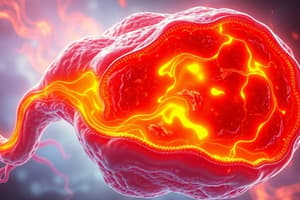Podcast
Questions and Answers
Why has the practical development of thermomagnetic generators (TMGs) been slow?
Why has the practical development of thermomagnetic generators (TMGs) been slow?
- Inability to convert heat into electricity efficiently
- High cost of manufacturing thermomagnetic generators
- Lack of suitable thermomagnetic materials with high Curie temperatures (correct)
- Limited availability of heat sources to power TMGs
What is the primary principle behind a thermomagnetic generator (TMG)?
What is the primary principle behind a thermomagnetic generator (TMG)?
- Conversion of heat into mechanical energy using a rotating chamber
- Conversion of heat into sound energy using a vibrating medium
- Conversion of heat into light energy using a thermochemical process
- Conversion of heat into electricity using electromagnetic induction (correct)
What is the main requirement for operating a Dynamic Heat Generator (DHG)?
What is the main requirement for operating a Dynamic Heat Generator (DHG)?
- Heat input from solar panels or geothermal sources
- High-pressure input from hydraulic systems
- Rotational input from devices like electric motor, combustion engine, or windmill (correct)
- Vibrational input from seismic activities
What is the typical application area for a Dynamic Heat Generator (DHG)?
What is the typical application area for a Dynamic Heat Generator (DHG)?
What is the conversion efficiency of a thermomagnetic generator (TMG) compared to the theoretical maximum?
What is the conversion efficiency of a thermomagnetic generator (TMG) compared to the theoretical maximum?
What are the primary processes that generate heat for potential conversion in various heat generators?
What are the primary processes that generate heat for potential conversion in various heat generators?
What is the main purpose of a thermoelectric generator (TEG)?
What is the main purpose of a thermoelectric generator (TEG)?
How does a flexible thermoelectric generator (FTEG) differ from a traditional TEG?
How does a flexible thermoelectric generator (FTEG) differ from a traditional TEG?
Why has the widespread adoption of TEG been limited?
Why has the widespread adoption of TEG been limited?
For what purpose have flexible thermoelectric generators (FTEGs) been proposed as a solution?
For what purpose have flexible thermoelectric generators (FTEGs) been proposed as a solution?
What potential impact do heat generation and conversion technologies have on various industries?
What potential impact do heat generation and conversion technologies have on various industries?
What is the potential outcome of further research and development in heat-to-energy conversion technologies?
What is the potential outcome of further research and development in heat-to-energy conversion technologies?
Flashcards are hidden until you start studying
Study Notes
Heat Generation and Conversion
Heat is a form of energy that is generated by various processes, such as friction, combustion, and nuclear reactions. In recent years, there has been growing interest in converting waste heat into electricity using advanced technologies. This article will discuss different types of heat generators and their applications.
Thermomagnetic Generator (TMG)
A thermomagnetic generator (TMG) is a device that converts heat into electricity based on the Faraday's law of electromagnetic induction. The performance of a TMG mainly relies on the temperature-driven phase transition of the thermomagnetic material. The conversion efficiency of a TMG can reach as high as 55% of the theoretical maximum. However, the practical development of TMGs has been slow due to the lack of suitable thermomagnetic materials with high Curie temperatures.
Dynamic Heat Generator (DHG)
A Dynamic Heat Generator (DHG) creates heat by shearing the fluid, which is contained within a rotating chamber. The DHG requires rotational input, which can be provided by an electric motor, combustion engine, turbine, windmill, or similar device. This type of generator is best suited for applications that require a high-frequency response and low output current, such as electronic devices and small appliances.
Thermoelectric Generator (TEG)
A thermoelectric generator (TEG), also known as a Seebeck generator, is a solid-state device that converts heat driven by temperature differences directly into electricity. TEGs have been considered for various applications, including automotive and industrial systems. However, their widespread adoption has been limited by factors such as low conversion efficiency and high cost.
Flexible Thermoelectric Generator (FTEG)
A flexible thermoelectric generator (FTEG) is a type of TEG that uses a flexible thermoelectric material to generate electricity from temperature differences. FTEGs have been proposed as a solution for powering wearable devices, such as smartwatches and health monitors. These generators can be integrated with energy management systems to provide efficient and reliable power supplies for wearable devices.
In conclusion, heat generation and conversion technologies have the potential to revolutionize various industries, from powering wearable devices to improving energy efficiency in industrial systems. Further research and development in these areas can lead to the development of more efficient and practical heat-to-energy conversion technologies.
Studying That Suits You
Use AI to generate personalized quizzes and flashcards to suit your learning preferences.



